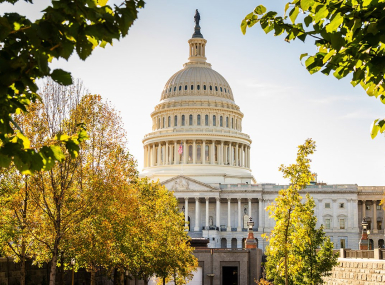Statehouse action: Boom or bust for counties?

Seemingly every legislator in Arizona found a new interest in 2021: Elections.
“We had far more election legislation introduced than in my 20 years in this job — far more,” said Jennifer Marson, executive director of the Arizona Association of Counties.
“There’s always a legislator who is your go-to person for drunk driving, there’s one who is your go-to person for taxation, we had a couple who were election people but this year, everyone wanted to be known as the person who fixed elections,” she noted. “It’s been an election bonanza.”
One bill proposed ousting the Board of Supervisors and the recorder and barring them from elected office if the live feed of the vote count went down.
Fortunately for counties, few found traction, but the issue wasn’t confined to the Grand Canyon State.
Learn More
State legislators ‘have to work closely’ with county counterparts
While Arizona’s painstaking audit of Maricopa County’s elections garnered national headlines, there was a canopy of bills in statehouses throughout the country aimed at adjusting county-run elections.
While Arizona officials are safe from election blowback, the Iowa Secretary of State can now fine or remove county auditors if the secretary believes they’ve made a mistake.
“It’s pretty disappointing,” said Bill Peterson, executive director of the Iowa State Association of Counties. “Iowa has had a history of free and fair elections. Our auditors do a great job.”
The Legislature also reduced the absentee ballot timeline for counties and shortened the window for early voting.
North Dakota counties came out unscathed, though, and perhaps better off.
“I think we had 40 different bills that would have done mostly terrible things to our election process and election workers, but I think we came out of it with some improvements, actually,” said Terry Traynor, executive director of the North Dakota Association of Counties.
“A little more time for processing absentee ballots, no changes with the authority of local governments to run elections. The only restriction was being banned from taking funding from a national nonprofit group assisting with voting because of COVID, but only a few counties did that.”
Pennsylvania counties are seeking changes to state law that will improve their ability to administer mail-in ballots, which were first made available to all voters in 2020.
They’re hoping to also ensure they can participate in developing meaningful election law reforms that create positive, effective election policy clarifications moving forward, and craft language that allows counties to implement amendments with sufficient time and appropriate resources to support any new requirements.
During the spring of 2021, Illinois Gov. J.B. Pritzker signed an omnibus election bill making mail-in balloting and curbside voting a permanent feature of Illinois elections.
The law creates a pilot program requiring all election authorities to establish in 2022 at least one location where anyone in that county or municipality can vote on Election Day and grants permissive authority for county sheriffs to offer ballot booths within county jails. Cook County is currently mandated to do so based upon a law enacted in 2020.
States are exploring more than local control of elections. In Colorado, outcry over housing prices is prompting legislators to scrutinize county land-use practices, fees, inspection and costs.
“We find that the dominant narratives seem to be that local government regulations are creating challenges in affordable housing, and honestly that’s really disappointing,” said Gini Pingenot, director of external affairs for Colorado Counties Inc. “It seems to turn a blind eye to the cost of land, the cost of construction, the profit margin that occurs, the frenzy of the market driving prices up. What people seem to focus on is the infrastructure costs, the direct and indirect services local governments provide.”
Pingenot’s analysis of Colorado counties’ conflict with the legislature over land-use could be extrapolated to other topics in other states.
“The disconnect between local government leadership and citizens who want their community to look a certain way, which is why they have land use and zoning, and then the state legislature and the governor who are more disconnected from the energy that is occurring at the local level,” she said.
“County commissioners are really in sync and having the state legislature insert themselves in some of these really strongly rooted land use practices that come from the community itself over time and create a tension we’re all trying to avoid.”
In some states, counties had to fight back against legislators who thought the American Rescue Plan’s direct funding to counties meant the states could cut back on their revenue sharing.
Wyoming counties have a revenue-sharing agreement to replace past tax revenues that the legislature exempted, which they fight for every two years, including 2021.
“Our funding incoming is seen by some as a replacement for that funding source,” said Jerimiah Rieman, executive director of the Wyoming County Commissioners Association. “This is not a one-for-one replacement.”
Rural broadband access is among the top priorities for counties in many states, including Texas, where Gov. Greg Abbott (R) signed a bill June 15 that creates a broadband development office to establish a statewide broadband plan.
Just north of Texas, in Arkansas, a House bill there will establish broadband improvement districts.
As always, state restrictions on taxation, or in some cases budgetary control, represents a threat for counties to be able to fund their own operations as they see fit.
In Nebraska, some bills have sought to restrict counties’ control over property taxes, either restricting increases or reducing valuation bases.
Others have targeted inheritance taxes, which are some counties’ only way of building reserves.
A bill signed by Georgia Gov. Brian Kemp (R) restricts a county government from reducing its police department budget by more than 5 percent.
“This is the first time in Georgia that the state has preempted our county governing authorities from having full control over budgeting for county services. This was done for political reasons,” said Dave Willis, executive director of Advancing Georgia’s Counties.
“It was a response to the national ‘defund the police’ movement and several cities that were considering lowering their police department budgets and moving funds to other services like mental health that they believed would have a more positive impact on crime prevention,” he noted.
“When the state interferes with the local budget decisions, it erodes local control and the ability of county commissioners to be responsive to their constituents. We hope [the bill] does not set a precedent for future legislation where state elected officials disagree with the priorities of local elected officials and thereby try to override the local authority with state law.”
Some counties are primed for big years, though. California’s legislature is aiming for a $12 billion broadband proposal, $8 billion - $12 billion for homelessness and $5 billion for wildfire and drought remediation.
“We’re going to make substantial progress on our top three priorities with dollars we have never seen before,” said CSAC Executive Director Graham Knaus, “because there’s so much money floating around.”
Legislatures all over the country took a variety of actions affecting county governments, including:
- Many Colorado bills incorporate attention to diversity, equity and inclusion issues.
- In Florida, preemptions of authority to the state and away from local governments were passed primarily in the areas of regulation of occupations and the ability to use a residence as a business and local authority over fuel or energy.
- Rural electric cooperatives have been given the authority to provide broadband services in the unserved or underserved areas of Georgia.
- The Idaho Legislature significantly reduced counties’ liability for the emergency medical costs of the uninsured.
- A Nevada bail reform effort will mandate initial court appearances within 48 hours, which will affect rural counties that typically have one judge. The Legislature decriminalized traffic offenses but civil fees will still fund court operations. Counties beat back an effort that would have cut them out of mining tax proceeds.
- Indiana counties fought for local control of siting for wind and solar projects
- New Mexico counties are open to millions of dollars more in liability after the Legislature put a $2 million cap on damages per claimant, not per violation of state constitution by law enforcement.
- Because the downturn in the oil market tanked North Dakota’s budget, counties were on their own financially in 2020.
- The drought has particularly affected central and eastern Oregon, which has affected water rights issues and trickled down to wildfire and timber management. The House and Senate have passed a bill allowing camping on public property, which will open vast areas to homeless encampments without funding to provide services.
- The South Carolina Association of Counties is pursuing a bill that would allow counties to impose both a local Capital Projects Sales Tax and Transportation Infrastructure Tax. Current law requires a county to implement only one of these taxes. Having the ability to implement both simultaneously would allow counties, with the approval of their taxpayers, to respond to the growth needs of the county without the approval or oversight of the state.
- The pandemic’s budgetary impact prompted the Washington Legislature to pass a bill allowing certain existing revenues to be used for broader expenses than they had previous been allowed, generally through 2023. The legislature failed to provide additional funding for trial court public defense services, despite a substantial growth in state revenues.
- Wisconsin created a regional network of community behavioral health facilities.

Attachments
Related News

U.S. Congress releases minibus funding package
U.S. House and Senate appropriators introduced a “minibus” appropriations package containing Fiscal Year (FY) 2025 Interior-Environment, Commerce-Justice-Science and Energy-Water spending bills.

County Countdown – Dec. 15, 2025
Every other week, NACo's County Countdown reviews top federal policy advocacy items with an eye towards counties and the intergovernmental partnership.

County Countdown – Dec. 1, 2025
Every other week, NACo's County Countdown reviews top federal policy advocacy items with an eye towards counties and the intergovernmental partnership.
